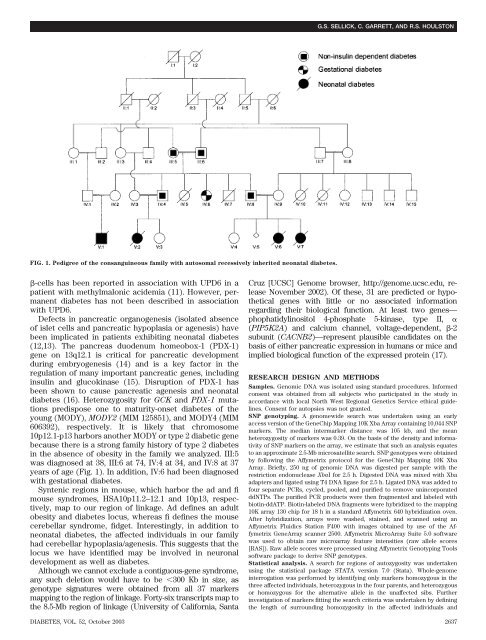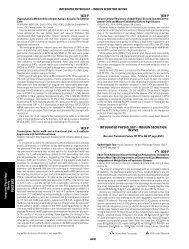A Novel Gene for Neonatal Diabetes Maps to Chromosome 10p12 ...
A Novel Gene for Neonatal Diabetes Maps to Chromosome 10p12 ...
A Novel Gene for Neonatal Diabetes Maps to Chromosome 10p12 ...
You also want an ePaper? Increase the reach of your titles
YUMPU automatically turns print PDFs into web optimized ePapers that Google loves.
FIG. 1. Pedigree of the consanguineous family with au<strong>to</strong>somal recessively inherited neonatal diabetes.<br />
-cells has been reported in association with UPD6 in a<br />
patient with methylmalonic acidemia (11). However, permanent<br />
diabetes has not been described in association<br />
with UPD6.<br />
Defects in pancreatic organogenesis (isolated absence<br />
of islet cells and pancreatic hypoplasia or agenesis) have<br />
been implicated in patients exhibiting neonatal diabetes<br />
(12,13). The pancreas duodenum homeobox-1 (PDX-1)<br />
gene on 13q12.1 is critical <strong>for</strong> pancreatic development<br />
during embryogenesis (14) and is a key fac<strong>to</strong>r in the<br />
regulation of many important pancreatic genes, including<br />
insulin and glucokinase (15). Disruption of PDX-1 has<br />
been shown <strong>to</strong> cause pancreatic agenesis and neonatal<br />
diabetes (16). Heterozygosity <strong>for</strong> GCK and PDX-1 mutations<br />
predispose one <strong>to</strong> maturity-onset diabetes of the<br />
young (MODY), MODY2 (MIM 125851), and MODY4 (MIM<br />
606392), respectively. It is likely that chromosome<br />
<strong>10p12</strong>.1-p13 harbors another MODY or type 2 diabetic gene<br />
because there is a strong family his<strong>to</strong>ry of type 2 diabetes<br />
in the absence of obesity in the family we analyzed. III:5<br />
was diagnosed at 38, III:6 at 74, IV:4 at 34, and IV:8 at 37<br />
years of age (Fig. 1). In addition, IV:6 had been diagnosed<br />
with gestational diabetes.<br />
Syntenic regions in mouse, which harbor the ad and fi<br />
mouse syndromes, HSA10p11.2–12.1 and 10p13, respectively,<br />
map <strong>to</strong> our region of linkage. Ad defines an adult<br />
obesity and diabetes locus, whereas fi defines the mouse<br />
cerebellar syndrome, fidget. Interestingly, in addition <strong>to</strong><br />
neonatal diabetes, the affected individuals in our family<br />
had cerebellar hypoplasia/agenesis. This suggests that the<br />
locus we have identified may be involved in neuronal<br />
development as well as diabetes.<br />
Although we cannot exclude a contiguous-gene syndrome,<br />
any such deletion would have <strong>to</strong> be 300 Kb in size, as<br />
genotype signatures were obtained from all 37 markers<br />
mapping <strong>to</strong> the region of linkage. Forty-six transcripts map <strong>to</strong><br />
the 8.5-Mb region of linkage (University of Cali<strong>for</strong>nia, Santa<br />
G.S. SELLICK, C. GARRETT, AND R.S. HOULSTON<br />
Cruz [UCSC] Genome browser, http://genome.ucsc.edu, release<br />
November 2002). Of these, 31 are predicted or hypothetical<br />
genes with little or no associated in<strong>for</strong>mation<br />
regarding their biological function. At least two genes—<br />
phophatidylinosi<strong>to</strong>l 4-phosphate 5-kinase, type II, <br />
(PIP5K2A) and calcium channel, voltage-dependent, -2<br />
subunit (CACNB2)—represent plausible candidates on the<br />
basis of either pancreatic expression in humans or mice and<br />
implied biological function of the expressed protein (17).<br />
RESEARCH DESIGN AND METHODS<br />
Samples. Genomic DNA was isolated using standard procedures. In<strong>for</strong>med<br />
consent was obtained from all subjects who participated in the study in<br />
accordance with local North West Regional <strong>Gene</strong>tics Service ethical guidelines.<br />
Consent <strong>for</strong> au<strong>to</strong>psies was not granted.<br />
SNP genotyping. A genomewide search was undertaken using an early<br />
access version of the <strong>Gene</strong>Chip Mapping 10K Xba Array containing 10,044 SNP<br />
markers. The median intermarker distance was 105 kb, and the mean<br />
heterozygosity of markers was 0.39. On the basis of the density and in<strong>for</strong>mativity<br />
of SNP markers on the array, we estimate that such an analysis equates<br />
<strong>to</strong> an approximate 2.5-Mb microsatellite search. SNP genotypes were obtained<br />
by following the Affymetrix pro<strong>to</strong>col <strong>for</strong> the <strong>Gene</strong>Chip Mapping 10K Xba<br />
Array. Briefly, 250 ng of genomic DNA was digested per sample with the<br />
restriction endonuclease XbaI <strong>for</strong> 2.5 h. Digested DNA was mixed with Xba<br />
adapters and ligated using T4 DNA ligase <strong>for</strong> 2.5 h. Ligated DNA was added <strong>to</strong><br />
four separate PCRs, cycled, pooled, and purified <strong>to</strong> remove unincorporated<br />
ddNTPs. The purified PCR products were then fragmented and labeled with<br />
biotin-ddATP. Biotin-labeled DNA fragments were hybridized <strong>to</strong> the mapping<br />
10K array 130 chip <strong>for</strong> 18 h in a standard Affymetrix 640 hybridization oven.<br />
After hybridization, arrays were washed, stained, and scanned using an<br />
Affymetrix Fluidics Station F400 with images obtained by use of the Affymetrix<br />
<strong>Gene</strong>Array scanner 2500. Affymetrix MicroArray Suite 5.0 software<br />
was used <strong>to</strong> obtain raw microarray feature intensities (raw allele scores<br />
[RAS]). Raw allele scores were processed using Affymetrix Genotyping Tools<br />
software package <strong>to</strong> derive SNP genotypes.<br />
Statistical analysis. A search <strong>for</strong> regions of au<strong>to</strong>zygosity was undertaken<br />
using the statistical package STATA version 7.0 (Stata). Whole-genome<br />
interrogation was per<strong>for</strong>med by identifying only markers homozygous in the<br />
three affected individuals, heterozygous in the four parents, and heterozygous<br />
or homozygous <strong>for</strong> the alternative allele in the unaffected sibs. Further<br />
investigation of markers fitting the search criteria was undertaken by defining<br />
the length of surrounding homozygosity in the affected individuals and<br />
DIABETES, VOL. 52, Oc<strong>to</strong>ber 2003 2637
















